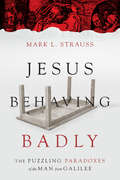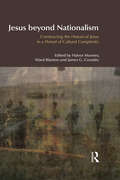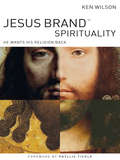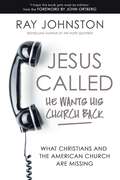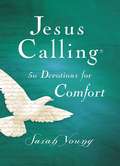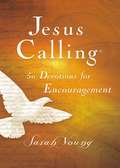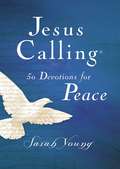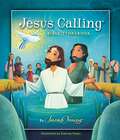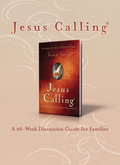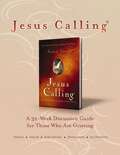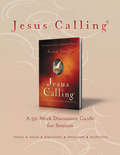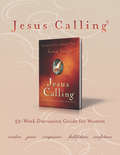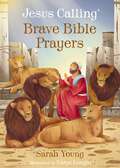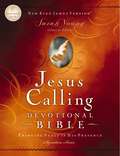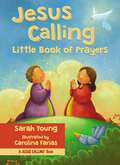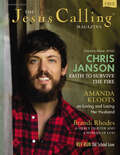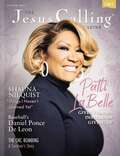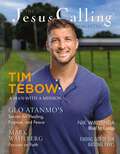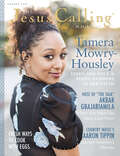- Table View
- List View
Jesus Behaving Badly: The Puzzling Paradoxes of the Man from Galilee
by Mark L. StraussJudgmental—preaching hellfire far more than the apostle PaulUncompromising—telling people to hate their familiesChauvinistic—excluding women from leadershipRacist—insulting people from other ethnic groupsAnti-environmental—cursing a fig tree and affirming animal sacrificeAngry—overturning tables and chasing moneychangers in the temple
Jesus Beyond Nationalism: Constructing the Historical Jesus in a Period of Cultural Complexity (BibleWorld)
by Ward Blanton James G. Crossley Halvor MoxnesThe study of Jesus has rarely looked at its own scholarly context, at how the representation of Jesus might be shaped by those who study him. 'Jesus beyond Nationalism' examines how - since the beginnings of historical Jesus studies in the nineteenth century - representations of Jesus have been used to promote hegemonic or mono-cultural views. The ideology behind such representation has operated to deny difference in society, difference in terms of race, ethnicity, gender, and sexuality. Examining depictions of Jesus in a range of contexts - from the Russian Christ and Jesus as 'Holy Anarchist' to Jesus in Muslim thought - Jesus Beyond Nationalism reveals the politics behind the ways in which Jesus has been constructed and presented.
Jesus Bible Study Guide: The God Who Knows Your Name
by Max LucadoDo you find it more difficult to think of Jesus Christ as a human, like you, than to think of him as God? You may believe in God, and you may believe Jesus is God, but many Christians find it difficult to think of him as a real person--fully human as he was fully divine.Award-winning author Max Lucado reveals in this video Bible study (DVD/streaming video sold separately) that in order to really know God and understand the Gospel, it's essential that we take a closer look at Jesus' humanity.The concept of Jesus' human and heavenly nature is difficult to wrap our minds around. He's the God who formed the universe and, at the same time, knows your personal struggles...because he went through the same things. For thirty-three years, Jesus felt everything you have ever felt. Weakness. Weariness. Sadness. Rejection. His feet got tired. His head ached. He was tempted and his strength was tested.The purpose of this study is simple: by journeying through these six lessons with a small group, you will get to know Jesus—and, therefore, God—like you never have before. And by learning more about the person Jesus was and is, we come to understand more clearly the people we were created to be.The Jesus Study Guide includes:Video teaching notesGroup discussion questions and activitiesBible exploration and prayersWeekly personal study and reflection materials.Get ready to study who Jesus was while he walked this earth and what that means for your life today. In doing this, you will get to know God, his purpose for you, and his love for you like you never have before.*Designed for use with the Jesus: The God Who Knows Your Name Video Study, available on DVD or streaming video, sold separately.
Jesus Brand Spirituality
by Ken Wilson"Jesus wants his religion back...so it can be for the world again" So begins this expertly written book by Ken Wilson, a pastor, practitioner and pilgrim to engage those drawn to the fascinating figure buried in the messy field of religion. Jesus Brand Spirituality is for those disillusioned by the current swirl of cultural conflict, moralism, and religious meanness that amounts to a form of trademark infringement on the movement that bears his name. Combining candor, curiosity and rare insight, the author explores four dimensions of the spirituality Jesus left in his wake--active, contemplative, biblical, and communal. Practical, engaging and compelling, this fresh illumination of an ancient path is both moving and thought provoking. Phyllis Tickle, founding editor of the Religion Department at Publisher's weekly calls Wilson "one of America's most gifted evangelicals, a thoughtful, unflinching pastor for thinking Christians; but he has outdone even his own reputation here. Candid, confessional, and full of stories, these conversational chapters from a man enthralled with Jesus are shot through with the passion and the realism of an eternally-vital romance."
Jesus Called – He Wants His Church Back: What Christians and the American Church are Missing
by Ray JohnstonAs early as 50 AD, Christians had gotten away from knowing who Jesus really is. Our generation is no different. In every decade we, as Americans, lost something important that we couldn't afford to lose: In the 1950's, we lost innocence In the 1960's, we lost respect for authority In the 1970's, we lost love In the 1980's, we lost values In the 1990's, we lost faith In the 2000's, we lost security In the 2010's, we lost hope in the future What can restore what we've lost? Only Jesus. Jesus gave us His name, His friendship, and a commission to accept responsibility for ourselves and for the world. When introduced to His wordsandways we'll rediscover the Jesus who: Wants His enemies won over, not wiped out Wants you to stop playing it safe Believed great things were possible no matter what things are like right now Was full of grace and truth Unleashed compassion Believed no one was too far from God to return to Him Came to seek and to save that which was lost Loves the church Pastor Ray Johnston shares the Jesus of the Bible and how we can be Christians without being jerks. He reveals how the radical message of the gospel calls us to love and serve not only our neighbors but our enemies as well. That's the Jesus the American Church has missed and needs to meet. Jesus' mission is clear--risk everything in order to take care of people, starting in our home, neighborhoods, cities, and those in need around the world. That's the Jesus the American Church has missed and needs to meet.
Jesus Calling 50 Devotions for Comfort
by Sarah YoungMore than 20 million people have been touched by Jesus Calling®. Experience Sarah’s words in a new way, focused specifically on the comfort only Jesus can provide. The Jesus Calling topical devotionals—releasing simultaneously—each feature 50 readings from Jesus Calling with relevant Scripture verses on the topics of comfort, peace, and encouragement.Through the scrapes, upsets, and meltdowns of life, loving parents offer comfort to their child. Our Lord longs to do the same to you. Jesus Calling 50 Devotions for Comfort is written as though Jesus Himself is speaking hope and comfort directly to your heart.Readers around the world already love how Sarah’s words connect with them on a daily basis. Now the new Jesus Calling topical devotionals offer a way to focus even more deeply on the major felt needs in your life . . . and in the lives of your friends, family, church, school, and co-workers.With a beautiful, vibrant cover and stunning four-color photography, this topical devotional is a natural addition to the Sarah Young brand—and the perfect way to pour into those you love.
Jesus Calling 50 Devotions for Encouragement
by Sarah YoungMore than 20 million people have been touched by Jesus Calling®. Experience Sarah’s words in a new way, focused on the encouragement only Jesus provides. The Jesus Calling topical devotionals—releasing simultaneously—each feature 50 readings from Jesus Calling with relevant Scripture verses on the topics of comfort, peace, and encouragement.Even the tiniest hill can feel like a mountain when you’re drained or discouraged. But that’s when your precious Savior reaches out His hand with compassion and draws you near. Jesus Calling 50 Devotions for Encouragement is written as if Jesus Himself is speaking hope and encouragement directly to your heart.Readers around the world already love how Sarah’s words connect with them on a daily basis. Now the new Jesus Calling topical devotionals offer a way to focus even more deeply on the major felt needs in your life . . . and in the lives of your friends, family, church, school, and co-workers.With a beautiful, vibrant cover and stunning four-color photography, this topical devotional is a natural addition to the Sarah Young brand—and the perfect way to pour into those you love.
Jesus Calling 50 Devotions for Peace
by Sarah YoungMore than 20 million people have been touched by Jesus Calling®. Experience Sarah’s words in a new way, focused specifically on the peace only Jesus provides. The Jesus Calling topical devotionals—releasing simultaneously—each feature 50 readings from Jesus Calling with relevant Scripture verses on the topics of comfort, peace, and encouragement.Life can be noisy. Pressures, tasks, and anxieties never cease, and sometimes the peace Jesus promises can seem unreachable. But it’s closer than you think. Jesus Calling 50 Devotions for Peace is written as if Jesus Himself is speaking directly to your heart, saying, “Peace. Be still.”Readers around the world already love how Sarah’s words connect with them on a daily basis. Now the new Jesus Calling topical devotionals offer a way to focus even more deeply on the major felt needs in your life . . . and in the lives of your friends, family, church, school, and co-workers.With a beautiful, vibrant cover and stunning four-color photography, this topical devotional is a natural addition to the Sarah Young brand—and the perfect way to pour into those you love.
Jesus Calling Bible Storybook (Jesus Calling®)
by Sarah YoungNothing in heaven or on earth can stop Me from loving you.Jesus is calling out to our hearts, and you can hear His voice in every story in the Bible. These carefully selected stories are paired with new children&’s devotions from Sarah Young and will help young hearts understand God&’s grand plan to send His Son, Jesus, to save His children and prepare a place for us in heaven. Bestselling author Sarah Young has touched millions of lives through her devotionals based on Scripture and written as though Jesus is speaking directly to the reader. This book will lead God&’s children, young and old, to talk to Jesus through prayer and to listen to His voice speaking love to their hearts.
Jesus Calling Book Club Discussion Guide for Families
by Thomas NelsonExperience peace in the presence of the Savior who is closer than you can imagine with the Jesus Calling® Discussion Guide for Families
Jesus Calling Book Club Discussion Guide for Grief (Jesus Calling®)
by Sarah YoungExperience peace in the presence of the Savior who is closer than you can imagine with the Jesus Calling® Discussion Guide for Grief.
Jesus Calling Book Club Discussion Guide for Seniors
by Sarah YoungExperience peace in the presence of the Savior who is closer than you can imagine with the Jesus Calling® Discussion Guide for Seniors
Jesus Calling Book Club Discussion Guide for Women
by Sarah YoungExperience peace in the presence of the Savior who is closer than you can imagine with the Jesus Calling® Discussion Guide for Women. The Jesus Calling Discussion Guide for Women is a 52-week discussion guide that uses relevant passages from the bestselling daily devotional Jesus Calling®that speak to the heart of a woman. This guide is filled with questions that will inspire you to apply the truths of Jesus Calling® to daily life. Anchored by related Scripture, each weekly topic covers a wealth of subjects that speak to the heart of a woman's faith, such as understanding your purpose, finding joy in hard times, defining true love and acceptance, combating burnout, and growing in grace and wisdom. Use the questions for your own personal reflection, or utilize them in a group setting for Sunday school, home study groups, women's ministry groups, and more. Discussion questions enhance a woman's weekly study of Jesus Calling: Enjoying Peace in His Presence by Sarah Young
Jesus Calling Brave Bible Prayers (Jesus Calling®)
by Sarah YoungChildren will experience the power of prayer in this collection of Bible stories from Sarah Young's bestselling Jesus Calling® series. Featuring the brave prayers of 10 people from the Bible, paired with short kid-friendly prayer prompts, this faith-filled book shows little ones that God helps us be mighty and He is always listening.Jesus Calling Brave Bible Prayersfeatures stories of Bible heroes' prayers and praises,includes simple prayers that will inspire little ones to talk with God and trust their heavenly Father, andwill help your family establish a routine of daily prayer.These stories of how God has answered prayers in the past will give children courage and the confidence that He hears them too. This encouraging board book is a meaningful gift for Easter, baby showers and dedications, adoption commemoration, and holiday gifting.Prayers include the following:Moses' praise song after crossing the Red SeaHannah's plea for a babyDavid's Psalm 23 to the Good ShepherdJesus' example of the Lord's PrayerDon't miss the other Jesus Calling books for little listeners:Jesus Calling for Little OnesJesus Calling My First Bible StorybookJesus Calling Advent & Christmas PrayersJesus Calling Easter PrayersJesus Calling Little Book of Prayers
Jesus Calling Devotional Bible, NKJV: Enjoying Peace in His Presence (Jesus Calling®)
by Sarah YoungThe Jesus Calling Devotional Bible puts readers in touch with God and His answers for their life situations. Missionary Sarah Young had been journaling her prayers for years when she began "listening" for what Jesus was saying to her within the words of Scripture. In this Bible, 260 scenarios pose life struggles to which Sarah Young gives answers from her Savior--words that Jesus has lovingly laid on her heart--words that have comforted and inspired Sarah and many others around the world.Features include:260 prayers with devotions by Sarah YoungHundreds of inspiring scriptures highlighted throughout the textNew King James Version® (NKJV) in paragraph formatIndex to devotionsTwo-color textPresentation pageRibbon markerPart of the Signature Series line of Thomas Nelson BiblesThe New King James Version--More than 60 million copies sold in 30 years
Jesus Calling Little Book of Prayers (Jesus Calling®)
by Sarah YoungTalking to God is easy! Featuring darling artwork alongside Scripture, a short message, and prayers on topics such as God&’s goodness, the importance of being kind, and how God makes our hearts happy, Jesus Calling® Little Book of Prayers will help even the littlest readers discover just how much God loves to hear from them.Help your children understand God&’s love and plan for their lives as they develop a habit of prayer early in life. Carolina Farias, illustrator of the hugely successful Jesus Calling® Bible Storybook, also illustrates this adorable board book for toddlers and preschoolers. Simple prayers inspired by God&’s Word will remind children that God made them, that He loves them, and that He loves to spend time with them. With simple language and engaging art, this sturdy board book will capture your little ones&’ attention as they discover how to talk to Jesus in prayer.
Jesus Calling Magazine Issue 10: Chris Janson (The Jesus Calling Magazine)
by Sarah YoungThis edition of The Jesus Calling Magazine features country singer-songwriter Chris Janson sharing how God guides his life and career; former WWE & AEW wrestler Brandi Rhodes talks about her life path; American television personality and Dancing with the Stars finalist Amanda Kloots gives her personal story of losing her husband to COVID-19; and Reverend Run, founding member of the chart-topping hip hop group Run-DMC, explains how his marriage is based on old school love.The Jesus Calling Magazine is a companion resource to Sarah Young's New York Times bestselling devotional, which has impacted the lives of more than 40 million people. These stories of hope will inspire you and equip you with tools to strengthen your relationships with family, friends, and yourself.The Jesus Calling Magazine will encourage you through:Interviews with well-known artists, authors, and entertainers"Doing Good" feature, spotlighting non-profits and everyday heroes serving their community in the name of ChristMusic spotlight showcasing musicians and performers using their gifts for God's gloryPastor's Corner with inspiration words from leading Christian teachersEntertaining puzzles and games for the familyRead additional issues of The Jesus Calling Magazine and look for more life-changing, life-giving books from Sarah Young, including:Jesus ListensJesus AlwaysJesus Today
Jesus Calling Magazine Issue 11: Patti LaBelle (The Jesus Calling Magazine)
by Sarah YoungThe spring issue of The Jesus Calling Magazine includes an in-depth interview with the incomparable performer Patti LaBelle, read the incredibly moving story of survival and triumph by a victim of the Oklahoma City bombing, author Shauna Niequist explains how to "live lightly," GRAMMY-award winner Chiquis Rivera shares her faith, and meet songwriting brothers Brett and Brad Warren as they discuss addiction, loss, and recovery.The Jesus Calling Magazine is a companion resource to Sarah Young's New York Times bestselling devotional, which has impacted the lives of more than 40 million people. These stories of hope will inspire you and equip you with tools to strengthen your relationships with family, friends, and yourself.The Jesus Calling Magazine will encourage you through:Interviews with well-known artists, authors, and entertainers"Doing Good" feature, spotlighting non-profits and everyday heroes serving their community in the name of ChristMusic spotlight showcasing musicians and performers using their gifts for God's gloryPastor's Corner with inspiration words from leading Christian teachersEntertaining puzzles and games for the familyRead additional issues of The Jesus Calling Magazine and look for more life-changing, life-giving books from Sarah Young, including:Jesus ListensJesus AlwaysJesus Today
Jesus Calling Magazine Issue 12 (The Jesus Calling Magazine)
by Sarah YoungThis edition of The Jesus Calling Magazine features superstar athlete Tim Tebow discussing the incredible work done by his foundation, actor and producer Mark Wahlberg shares how God's guidance has shaped his career and his life, learn how travel blogger Glo Atanmo changed course after a health crisis, tight-rope walker Nik Wallenda talks about overcoming fear, sports analyst and former NFL player Sam Acho shares the message he wants everyone to know, and R&B singer Florence LaRue reflects on her career and finding grace in the second act of life.The Jesus Calling Magazine is a companion resource to Sarah Young's New York Times bestselling devotional, which has impacted the lives of more than 40 million people. These stories of hope will inspire you and equip you with tools to strengthen your relationships with family, friends, and yourself.The Jesus Calling Magazine will encourage you through:Interviews with well-known artists, authors, and entertainers"Doing Good" feature, spotlighting non-profits and everyday heroes serving their community in the name of ChristMusic spotlight showcasing musicians and performers using their gifts for God's gloryPastor's Corner with inspiration words from leading Christian teachersEntertaining puzzles and games for the familyRead additional issues of The Jesus Calling Magazine and look for more life-changing, life-giving books from Sarah Young, including:Jesus ListensJesus AlwaysJesus Today
Jesus Calling Magazine Issue 13 (The Jesus Calling Magazine)
by Sarah YoungThis edition of The Jesus Calling Magazine features actors and '90s icons Carlos and Alexa PenaVega as they talk about serving Jesus; educator and author Sonya Curry explains how God helps to complete us; Fox News' Ainsley Earhardt shares how she celebrates every child; country singer-songwriter Travis Tritt reveals how God guides his path; plus read about the Christmas traditions from some of your favorite celebrities.The Jesus Calling Magazine is a companion resource to Sarah Young's New York Times bestselling devotional, which has impacted the lives of more than 40 million people. These stories of hope will inspire you and equip you with tools to strengthen your relationships with family, friends, and yourself.The Jesus Calling Magazine will encourage you through: Interviews with well-known artists, authors, and entertainers "Doing Good" feature, spotlighting non-profits and everyday heroes serving their community in the name of Christ Music spotlight showcasing musicians and performers using their gifts for God's glory Pastor's Corner with inspiration words from leading Christian teachers Entertaining puzzles and games for the familyRead additional issues of The Jesus Calling Magazine and look for more life-changing, life-giving books from Sarah Young, including: Jesus Listens Jesus Always Jesus Today
Jesus Calling Magazine Issue 14: Chris Tomlin (The Jesus Calling Magazine)
by Sarah YoungThis edition of The Jesus Calling Magazine features the Grammy-award winning Christian music artist Chris Tomlin, actor Dean Cain talks about fatherhood, the Discovery Channel's Todd Hoffman shares how he's learned from his mistakes, Broadway's Kristin Chenoweth spreads her message of love to families, journalist and podcaster Paula Farris shares how faith guided her through difficult times, plus read more inspiring stories of faith and prayer. The Jesus Calling Magazine is a companion resource to Sarah Young's New York Times bestselling devotional, which has impacted the lives of more than 40 million people. These stories of hope will inspire you and equip you with tools to strengthen your relationships with family, friends, and yourself.The Jesus Calling Magazine will encourage you through:Interviews with well-known artists, authors, and entertainersMeet everyday heroes serving others in the name of ChristMusic spotlight showcasing musicians and performers using their gifts for God's gloryPastor's Corner with inspiration words from leading Christian teachersEntertaining games for the whole familyRead additional issues of The Jesus Calling Magazine and look for more life-changing, life-giving books from Sarah Young, including:Jesus ListensJesus AlwaysJesus Today
Jesus Calling Magazine Issue 15: Danica McKellar (The Jesus Calling Magazine)
by Sarah YoungThis edition of The Jesus Calling Magazine features The Wonder Years actress Danica McKellar shares how faith keeps her grounded, PGA golfer Bubba Watson talks about his darkest times, MLB pitcher Luke Weaver reveals how God keeps his dreams alive, and author Amy Hannon shares a recipe from her cookbook, Love, Welcome, Serve.The Jesus Calling Magazine is a companion resource to Sarah Young's New York Times bestselling devotional, which has impacted the lives of more than 46 million people. These stories of hope will inspire you and equip you with tools to strengthen your relationships with family, friends, and yourself.The Jesus Calling Magazine will encourage you through:Interviews with well-known artists, authors, and entertainersMeet everyday heroes serving others in the name of ChristMusic spotlight showcasing musicians and performers using their gifts for God's gloryPastor's Corner with inspiration words from leading Christian teachersEntertaining games for the whole familyRead additional issues of The Jesus Calling Magazine and look for more life-changing, life-giving books from Sarah Young, including:Jesus Listens®Jesus AlwaysJesus Today
Jesus Calling Magazine Issue 16: Tamara Mowry-Housley (The Jesus Calling Magazine)
by Sarah YoungThis edition of The Jesus Calling Magazine features Sister, Sister actress Tamara Mowry-Housely talking about growing up in Hollywood but staying true to faith, soccer star Walker Zimmerman explains how he models his relationships after Jesus, 90s country music star Aaron Tippin shares how supporting U.S troops has impacted his life and music, and American Ninja Warrior&’s Akbar Gbajabiamila reveals how joy is often on the other side of determination.The Jesus Calling Magazine is a companion resource to Sarah Young's New York Times bestselling devotional, which has impacted the lives of more than 45 million people. These stories of hope will inspire you and equip you with tools to strengthen your relationships with family, friends, and yourself.The Jesus Calling Magazine will encourage you through:Interviews with well-known artists, authors, and entertainersMeet everyday heroes serving others in the name of ChristMusic spotlight showcasing musicians and performers using their gifts for God's gloryPastor's Corner with inspiration words from leading Christian teachersEntertaining games for the whole familyRead additional issues of The Jesus Calling Magazine and look for more life-changing, life-giving books from Sarah Young, including:Jesus Listens®Jesus AlwaysJesus Today
Jesus Calling Magazine Issue 17: Reba McEntire (The Jesus Calling Magazine)
by Sarah YoungThis edition of The Jesus Calling Magazine features country music icon and actress Reba McEntire as she shares stories of her faith from throughout her life, world-famous tenor Andrea Bocelli talks about how he returned to the faith of his childhood, NASCAR&’s Kelley Earnhardt Miller reveals God&’s steadfast presence, and soul singer Merry Clayton&’s uses her music to spred God&’s message of love.The Jesus Calling Magazine is a companion resource to Sarah Young's New York Times bestselling devotional, which has impacted the lives of more than 46 million people. These stories of hope will inspire you and equip you with tools to strengthen your relationships with family, friends, and yourself.The Jesus Calling Magazine will encourage you through:Interviews with well-known artists, authors, and entertainersMeet everyday heroes serving others in the name of ChristMusic spotlight showcasing musicians and performers using their gifts for God's gloryPastor's Corner with inspiration words from leading Christian teachersEntertaining games for the whole familyRead additional issues of The Jesus Calling Magazine and look for more life-changing, life-giving books from Sarah Young, including:Jesus Listens®Jesus AlwaysJesus Today
Jesus Calling Magazine Issue 18: Sarah Young (The Jesus Calling Magazine)
by Sarah YoungIn this special edition of The Jesus Calling Magazine we remember author Sarah Young and the profound impact she had on readers around the world. This commemorative issue includes stories from readers and a special article from Sarah's daughter, Stephanie Young van der Westhuizen. Readers will also learn about the special friendship between country music's Walker Hayes and Pastor Craig Allen Cooper, the "basketball nun" Sister Jean Schmidt shares the importance of faith at any age, and designer Ahn Lin talks about reshaping homes to make beautiful lives.The Jesus Calling Magazine is a companion resource to Sarah Young's New York Times bestselling devotional, which has impacted the lives of more than 45 million people. These stories of hope will inspire you and equip you with tools to strengthen your relationships with family, friends, and yourself.The Jesus Calling Magazine will encourage you through:Interviews with well-known artists, authors, and entertainersMeet everyday heroes serving others in the name of ChristMusic spotlight showcasing musicians and performers using their gifts for God's gloryPastor's Corner with inspiration words from leading Christian teachersEntertaining games for the whole familyRead additional issues of The Jesus Calling Magazine and look for more life-changing, life-giving books from Sarah Young, including:Jesus ListensJesus AlwaysJesus Today
